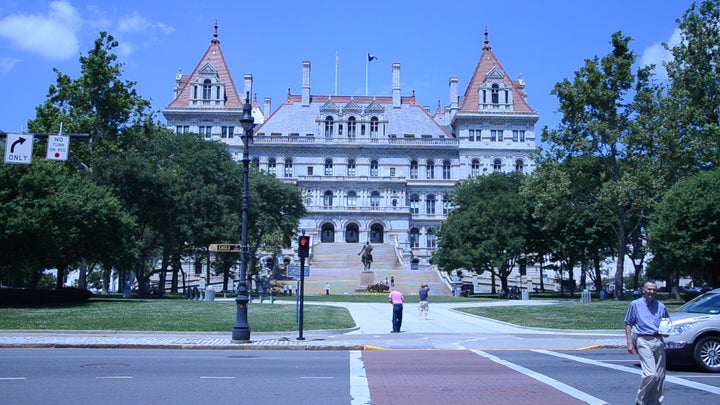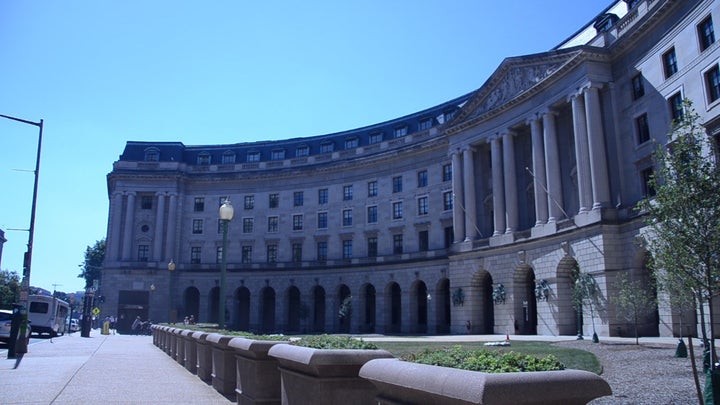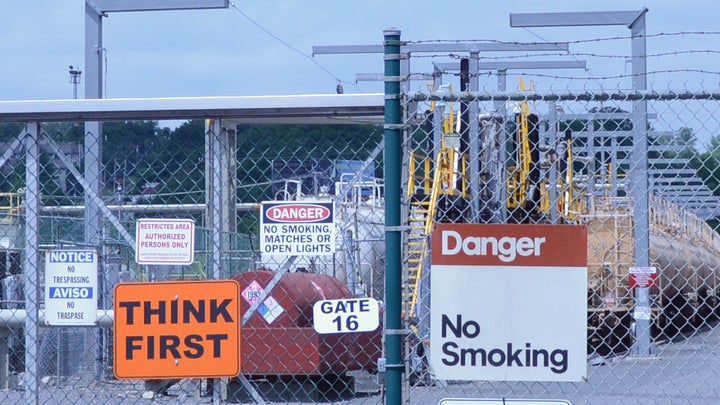what four things does the clean air act enable the epa to do
ALBANY, N.Y. — When Deneen Carter-El moved to the Ezra Prentice Homes in Albany'south Southward End 2 decades ago, she thought the beige-colored townhouses and trimmed lawns would be a welcome modify from high-rise public housing.
But appearances were deceiving.
The 16-building complex borders the Port of Albany — a 200-acre shipping hub that's habitation to landfills, coach depots, a cement plant and a large terminal where crude oil is transferred from railcars to barges and tankers. Only a concatenation-link contend separates the housing projection and its playground from the railyard. Today, Carter-El is convinced that Ezra Prentice is "a toxic dump."
"Not a day goes by when nosotros exit of the apartment and don't smell stuff," said the single female parent and cancer survivor who walks her 8-twelvemonth-one-time daughter to the omnibus on schoolhouse days. "You're almost scared to come outside."
The by and large African-American tenants of Ezra Prentice mutter of recurring headaches and nosebleeds and keep their windows shut, fifty-fifty on muggy July days like this 1, to avoid gas-like odors they suspect come from idling trains and trucks. Across the tracks, volatile, explosive crude oil from North Dakota is offloaded at Global Partners' Albany Terminal, a distributor to East Coast refineries and one of the largest sources of local air pollution.
The Southward Terminate is less than a five-minute bulldoze from the New York State Department of Ecology Conservation (DEC) and the chateau-style country Capitol, just people here say the proximity hasn't helped them. "Weeks get by, and months go by, and information technology's pushed under the carpeting again," said Carter-El, who's attended numerous meetings with regulators and politicians over the past three years.

Photo by Jie Jenny Zou The Center for Public Integrity
With the passage of the Clean Air Deed in 1970, Congress pledged to protect public wellness with the guarantee of safe air. The U.S. Ecology Protection Agency estimates that reduced emissions associated with the law prevented 160,000 deaths in 2010 alone.
The act relies on cooperation between federal and state regulators. But experts, including some at the EPA, say its benefits aren't being fully realized because enforcement remains wildly inconsistent.
The EPA has had problem analogous with recalcitrant states and territories, which are responsible for day-to-twenty-four hour period policing despite significant federal and country cutbacks. Incomplete and inaccurate data supplied by states to the EPA, forth with a patchy air-monitoring organisation, complicate attempts to identify problem areas.
The scarcity of data prompted the Eye for Public Integrity to file public-records requests with all 50 states, also equally the EPA and the U.S. Census Bureau, to try to appraise Clean Air Deed enforcement nationwide. Amongst the Center'south findings:
- Forty country ecology agencies accept reduced regulator head counts in contempo years, even as federal and country responsibilities accept proliferated and the state has largely recovered from the recession.
- North Carolina — which the EPA criticized earlier this year for coddling polluters — has suffered some of the deepest cuts, its agency's 2014 workforce cut by a 3rd from 2008 levels. In Illinois and Arizona, staffing has fallen past more than than a third since 2007. Over the same menstruum, New York'south workforce has been cut by nearly a quarter and Michigan's past a fifth.
- Florida has filed simply 1 Clean Air Human activity case involving asbestos — a mortiferous mineral long used in building materials — in the past three years. Georgia has handed over asbestos enforcement to the EPA, and Connecticut is considering doing so.
Researchers, sometime EPA officials, country regulators and others interviewed by the Center said it'due south incommunicable for states to maintain vigorous enforcement among significant cutbacks. Joel Mintz, a police force professor at Nova Southeastern University and a member of the left-leaning Center for Progressive Reform, said states are in a "clasp." Understaffed agencies are unable to revise weak, outdated permits, which cap facilities' emissions. Every bit a effect, he said, "there'south no progress made in the control of pollution."
The Clean Air Act itself remains contentious. A 2015 federal report plant that nearly 60 percent of all lawsuits against the EPA from 1995 to 2010 were filed under the act — far more than under whatever other program. In fact, 27 states are suing the EPA to block the Clean Power Plan, a cornerstone of President Obama'due south climate policy that would use the act to curb emissions at coal-fired power plants. Other state-led litigation claims that recently tightened ozone limits are as well costly for industry.
South End residents watched with skepticism as New York officials suddenly sprang into activity late this summer. Along with local activists and ecology groups, the residents had filed a lawsuit against Global in February, alleging the company mischaracterized its emissions when it applied for state approving in 2012 to increase fivefold the amount of petroleum products it handles — from 450 million to 2.iii billion gallons a year. (In a court filing, Global called the lawsuit "nothing more than than an improper collateral set on on a permit that [the plaintiffs] do not similar.")
Residents likewise began gathering their own data — donning face masks to count diesel truck traffic and knocking on dozens of tenants' doors to survey for chronic conditions similar emphysema and asthma. Their efforts caught the attention of Judith Enck, the EPA's elevation regional official, who met with members of the community in August. The month before, her office had filed a Clean Air Deed violation discover against Global dating to the 2012 expansion. Activists had long argued that the terminal was releasing excessive amounts of volatile organic compounds, such equally cancer-causing benzene.
The state has yet to allege a comparable violation but made news of its own. On the same day as Enck's visit in August, the DEC appear plans to increase air monitoring in the S Cease, marking a difference from ii years earlier, when information technology rebuffed residents' concerns. The day before, DEC Commissioner Basil Seggos urged the EPA to make "a stronger federal response to the concerns of the residents of South Albany." A few days afterwards, Seggos denounced EPA's oversight of longstanding efforts to remove polychlorinated biphenyls — homo-fabricated chemicals linked to neurological and other health issues — released into the Hudson River by General Electric Co.
Some chalked upward the Dec's string of announcements as lilliputian attempts to divert attention from unwelcome federal intervention. "Instead of buckling down and saying 'Oops, looks similar we made a error,' they plough it into a retribution war," said Chris Amato, an attorney with the public-interest law house Earthjustice, who is litigating the case confronting Global. "The but time you see [the December] doing something is when a lawsuit is filed or they get embarrassed because EPA came in and took the pb."

Photo past Jie Jenny Zou The Eye for Public Integrity
State officials maintain that the DEC "has been actively engaged" with the community from the start. In a statement to the Center in early on September, the bureau wrote that information technology understood the community's concerns, only said testing showed the air was improving and meets federal standards.
Nevertheless, a calendar week later, the Dec notified Global it would face stricter oversight in low-cal of "higher-than-expected benzene levels." December air-sampling results released in belatedly September showed the Southward End's average benzene levels for the past twelvemonth were comparable to those of the Buffalo-area neighborhood most Tonawanda Coke, which is shelling out a combined $36 million in criminal and civil lawsuits stemming from years of Clean Air Deed violations for uncontrolled benzene emissions.
Global declined an interview request, just wrote in a statement that it plans "to testify to the EPA, the DEC and our neighbors that our Albany facility remains in compliance with federal and land emission standards."
Cleaner air can't come soon plenty for Carter-El, who was recently diagnosed with asthma and spends her days juggling medical appointments. "I want to be able to grow old and see them," she said of her four children, who appear to exist in adept wellness. "I don't want them to come over here and be planning my funeral." She turns 50 this year.
'Stripped From The Bones'
After decades as the assemblyman from Manhattan'southward Upper E Side, Pete Grannis was set up to trade in politics for what he called his "dream job." In 2007, he was sworn in every bit Dec commissioner, putting him in accuse of the aforementioned agency that had hired him as a young lawyer in the 1970s.
Merely his triumphant return was cut curt by the fiscal crash. In his first 3 years on the job, the December lost more than than 300 staffers — a nearly 9 percent cut. In 2010, another 135 positions were eliminated. "I pushed dorsum and I pushed back equally hard as I could," Grannis said of the reductions, which he felt singled out the department.
He sent memos to and so-Gov. David Paterson warning that further cuts to the DEC'south air division could have lasting effects since enforcement relies on a "cops-on-the-route" presence. "All the meat has been stripped from the bones, and some of the bones have disappeared," Grannis wrote.
Soon later on the memos were leaked to the press, Paterson's secretary gave Grannis 2 options: submit a letter of resignation or exist fired immediately. He chose the latter; news of his dismissal acquired an uproar amid environmentalists who saw him as an ally struck down past pro-business politics.
Grannis at present works as a top administrator for the New York State Comptroller, whose office criticized the DEC's flat-lining budget and inadequate staffing despite expanding responsibilities in a 2014 study. The report warned that unchecked air emissions would put state residents at greater risk of death and illnesses such as cancer and asthma.
"Information technology's pretty clear they're doing less with less."
- Peter Iwanowicz, sometime New York State DEC acting commissioner, on the agency
The December has fewer than 2,900 full-time employees, down from 3,775 in 2007. Over the past decade, air-enforcement positions take also been cut by well-nigh a quarter. Terminal year, the agency referred just 85 air-related cases for civil enforcement, compared to 467 in 2007.
"Information technology'south pretty clear they're doing less with less," said Peter Iwanowicz, a erstwhile DEC acting commissioner who now heads Albany-based Environmental Advocates of New York.
Iwanowicz said overburdened regulators often lose sight of communities like the South End. He said he wasn't enlightened of the severity of the area's air-quality issues until oil-railroad train traffic began spiking in 2013 — three years later on he left the DEC.
Carter-El said the neighborhood has long been overlooked. It wasn't until afterwards the death of a second-grader in 2013 that officials outfitted South Pearl Street, the main road leading to Interstate 787, with proper traffic signals and signs, even though at to the lowest degree 10 children had been struck in previous accidents at that place. Earlier this year, S End residents celebrated the opening of a Family Dollar, the just convenience store nearby besides a small corner bodega.
New York Gov. Andrew Cuomo, a Democrat, has embraced climate-change initiatives but also supports expanding the Port of Albany — straining relations with activists who question his delivery to the environment. "The governor wants to view New York as open for business, even if information technology'due south dirty business," Iwanowicz said.
Known for his micro-management, Cuomo has clashed repeatedly with the EPA. The agency quashed his attempts in 2014 to use $511 million in federal water funds for span reconstruction. In August, Cuomo threatened to sue the EPA if plans to allow the dumping of dredged sediment from harbors and rivers into the Long Isle Sound are approved.
Over the past year, Cuomo's assistants also has taken oestrus for allegedly ignoring EPA warnings virtually drinking water tainted with perfluorooctanoic acid (PFOA), a suspected carcinogen, in the upstate community of Hoosick Falls. In early September, EPA Administrator Gina McCarthy urged the land to "movement beyond accusatory letters and, rather, work cooperatively" with EPA regional officials.
Cuomo's office declined to answer to questions from the Center, referring information technology to the Dec. The agency reiterated its commitment to the S Finish and wrote that "like any other industrial area that is in the vicinity of residences, utilization of the Port [of Albany] can be done in a manner that is consistent with the Governor's climate and environmental priorities."

Jie Jenny Zou The Center for Public Integrity
Deep Cuts In Pennsylvania, Florida
Heads of state agencies are typically nominated by governors, while budgets are subject to gubernatorial blessing — throwing regulators into the political fray. John Quigley was forced out as chief of Pennsylvania'south Department of Environmental Protection (DEP) in May afterward a profanity-filled email he sent to activists raised questions most his objectivity in a big oil and gas country. Though handpicked for the position by Gov. Tom Wolf, a Democrat, Quigley barely lasted a year and a half on the job.
Like Grannis, Quigley was vocal about deep cutbacks at his agency. Last year, the EPA flagged the DEP for inadequate air-enforcement staffing.
Florida's Department of Ecology Protection has faced a slide well-nigh identical to New York'due south, even as the state's economy has grown. The agency employs but over 2,900 people, compared to 3,600 in 2007. Republican Governor Rick Scott — who reportedly prohibited state workers from using the terms "climate alter" or "global warming" — has touted reduced processing times for permits as a sign of greater efficiency.
Only Florida's chapter of Public Employees for Environmental Responsibility, which advocates for stronger enforcement, blamed Scott's concern-friendly politics for a "severely crippled" department that allows polluters to skirt citations. The group's annual study found that xviii air enforcement cases were opened in 2015, compared to an almanac average of 93 in previous decades. The country has filed but one asbestos example since 2013 — compared to a past annual boilerplate of 13.
Bill Becker, manager of the National Association of Clean Air Agencies, testified before Congress in March that states have borne the burden of an annual $550 million federal funding shortfall. The Make clean Air Act calls for federal grants to embrace up to 60 percent of country air enforcement programs. In fact, states today are shouldering 75 percent of costs. The gap has caused "agencies to reduce or eliminate important air pollution programs, postpone necessary air monitoring expenditures and even reduce their workforces," Becker said.
The Center surveyed all l states and the District of Columbia, seeking a decade of agency staffing data. Forty-1 provided those numbers; for the remaining x, the Eye used half-dozen years of information obtained from the Census Agency. From 2009 to 2014, agencies that shed employees reported a typical decline of nearly 7 percent, though some took far bigger hits.
Shari Wilson, deputy assistant administrator in the EPA's enforcement sectionalization, said in an interview that the impacts of land budget shortfalls are magnified by increasing numbers of facilities and regulations. "The system gets stretched thinner and thinner and thinner," she said.
The EPA itself has been pared down. Its total-time workforce is under fourteen,400 employees, down from xvi,600 a decade ago. Staffing beyond all x regional EPA offices — which work directly with states — has also declined.
The cutbacks are especially severe since the agency has been inadequately funded from the start, said Mintz, the law professor. In a paper this twelvemonth, he pointed out that EPA funding in 2014, when adapted for inflation, was the everyman since 1977.
A Level Playing Field
It's hard to know, by any objective measure, which states are doing a good job of enforcing the Clean Air Human action. Of the dozens of people interviewed for this story, no two could agree on which states or EPA regions were excelling or failing.
Almanac enforcement metrics provided by states — such as inspections, violations, penalties — are riddled with "widespread and persistent information inaccuracy and incompleteness … which make it hard to identify when serious problems exist or to track state actions," the EPA wrote in a 2013 memo.
The EPA's Office of Inspector General has repeatedly raised concerns over uneven enforcement. In a 2011 audit, the office constitute that even top-performing state agencies failed to see national goals for basic duties like inspections and wrote that the EPA "cannot assure that Americans in all states are equally protected from the health effects of pollution."
Accountant Kathlene Butler said in an interview that the differences amid the states were stark. "It seemed some states were very clear on what was expected of them in terms of performance from the [EPA] region," she said. "Other states knew at that place was an ability to negotiate."
Wilson said the EPA has a better agreement at present of how states are faring than it did at the time of the audit. In a statement to the Heart, the agency wrote that its "relationship with the states is strong," and called edifice state partnerships a priority nether McCarthy. But the EPA has resisted calls by the inspector general for enforcement reform.
Eddie Terrill, air director at Oklahoma's Department of Environmental Quality, said he and other members of the National Association of Clean Air Agencies are eager for stronger EPA guidance but don't ever go it. As a result, he said, "Every state has a different perspective on how things ought to be washed."

Photo by Jie Jenny Zou The Center for Public Integrity
Mintz said tension between states and the EPA goes back to the bureau's creation in 1970. Before that, states were responsible for their ain ecology programs. Today's imperfect system reflects a compromise between those who wanted nationwide pollution standards and those who wanted states to retain individual control, he said.
The EPA provided few internal records on country performance requested by the Eye. Most forthcoming was the Southeast regional office in Atlanta, which has ramped upward oversight of North Carolina's Department of Ecology Quality (DEQ) after years of significantly fewer state-issued violations, paltry fines and failure to become after repeat offenders.
From 2011 to 2014, air-related penalties in North Carolina dropped by 93 percent while overall enforcement actions decreased by 51 percentage. "This raises concerns well-nigh effective deterrence and providing a 'level playing field,'" the EPA wrote to DEQ Secretary Donald van der Vaart in a May alphabetic character obtained by the Heart under the Freedom of Data Act. It was the latest attempt to get the DEQ to correct problems federal officials attribute to 2011 policies that made it easier for polluters to resolve violations informally and resulted in fewer penalties.
The Domtar pulp and paper mill in Plymouth, Due north Carolina, was amidst more than a dozen facilities flagged by the EPA for "chronic noncompliance." Company officials claimed the addition of a new biofuel plant in early 2013 wouldn't significantly increase air pollution, but waited until mid-2014 to notify regulators that emissions of hydrogen sulfide — a gas that can cause instant death in high concentrations and loss of smell and retentivity problems at lower levels — were heavier than projected.
The country fined Domtar $100,000 in June 2015 only immune the visitor to go along operating its new plant without the proper permit. A Domtar spokesman said the company is "working diligently with the state" on a new permit and installing a monitoring organisation.
The DEQ's Stephanie Hawco declined to respond to questions from the Center and said the agency will reply to the EPA's May letter afterwards this fall. Hawco also declined to respond questions about Domtar, saying just that "DEQ has protected public health by … ensuring [Domtar is] on a path toward getting into compliance."
The DEQ'southward 2014 ecology staffing levels were down by a third of what they were in 2008, according to state officials who provided the Centre with detailed figures. Over the same period, the air-enforcement staff was reduced by nearly a quarter.
N Carolina is among the states suing the EPA to try to block the Clean Power Plan. Secretary van der Vaart has been vocal most his opposition to the plan, calling it a federal "takeover." Three of the state'due south coal-fired ability plants were amid the nation's top 100 emitters of greenhouse gases in 2014, a Center analysis establish.
It'due south not uncommon for enforcement inadequacies to go unresolved long after they've been identified. Since 2009, the EPA has carried out enforcement of federal asbestos regulations on Georgia's behalf because of state upkeep reductions. In May, the EPA wrote in a separate internal review that Georgia officials had too blocked the agency from reviewing state air penalty records — an allegation a spokesperson for Georgia's Department of Natural Resources denied.
A 2013 EPA review of the Ohio Environmental Protection Agency plant state regulators improperly modified permits after pollution incidents instead of issuing violations. They also failed to report critical violations to the EPA every bit required — and then "it appears to EPA and the public that these things are non beingness done." No updates were provided in subsequent annual reports.
The EPA'southward New England office flagged "the loss of key enforcement staff in recent years" amidst the six states in its region as a major business organisation in March. The bureau has shouldered enforcement duties on Rhode Island's behalf, records show. Like to its counterpart in Georgia, Connecticut's Department of Free energy and Environmental Protection notified the EPA it may no longer carry out asbestos enforcement.
Empty Threat
When enforcement falls brusque of the EPA'southward expectations, the agency oftentimes resorts to cajoling states into improving, erstwhile EPA officials said. Phone calls or sternly worded letters are preferred over formal intervention, which requires the EPA to accept on added responsibilities.
Mounting force per unit area from the public and the EPA persuaded New York regulators to rethink Global's 2013 plans to install 7 natural-gas fired boilers at its Albany Concluding. The DEC originally concluded that the proposal, which would allow Global to handle thicker fuels like tar sands, wouldn't have "significant adverse impacts on the environment," simply to backtrack two years afterwards.
A big factor in the reversal was a 12-page letter the EPA sent to the state in April 2014, pointing out several missteps by the Dec. A week afterward the EPA sent a follow-up letter in May 2015, the DEC conceded that it hadn't considered whether Global'southward proposal would increase unintended releases known as fugitive emissions, worsen Albany's persistent ozone trouble or raise levels of hydrogen sulfide.
The state also failed to catch an error. While Global estimated its plan would increment emissions of volatile organic compounds past 39.v tons per twelvemonth — merely shy of a twoscore-ton threshold that triggers additional review and pollution controls — the EPA found the figure was closer to 44 tons.
"For whatever reason, DEC seems intent on giving this visitor the benefit of every doubt and overlook what we believe are clear cherry flags about how they're computing their emissions," Earthjustice'due south Amato said.

Jie Jenny Zou The Center for Public Integrity
Regional EPA officials played down their involvement in the Global case, denying that the violation discover they filed against the company in July reflected unhappiness with the DEC'due south performance. The officials declined to exist interviewed, writing in an email to the Center that they were in discussions with their country counterparts and that such discussions were "not unusual."
Experts say the EPA must tread advisedly when information technology comes to intervening in state matters or risk worsening tensions. Exterior of persuasion, the EPA has few methods to spur improvement.
The harshest is withdrawal, or taking dorsum a program, which strips enforcement authority from the country and puts it in federal easily. Because of the drain information technology puts on the EPA, some call the option an empty threat — likely to crusade more than bug than it would solve.
"You're basically undermining and weakening the organization rather than strengthening it," the EPA's Wilson said. "The fashion the organisation is gear up and the fashion information technology functions most effectively is to have the strongest country programme possible."
The EPA did not respond to a Center request to provide records or figures on how many land programs the agency has withdrawn. Similarly, information technology did not provide statistics on how many withdrawal requests it had received from exterior environmental groups like the Sierra Guild, or how many times it had withheld federal grant coin from state agencies — one of the more than forceful oversight options.
The EPA's inspector general recommended that the bureau withdraw the Virgin Islands' authority for several environmental programs in 2015, citing a plethora of issues, but the EPA refused to exercise so. Officials had taken the unusual stride of temporarily blocking the U.S. territory from accessing $37 meg in federal funds, citing concerns over poor financial oversight.
An audit the same year said inspectors in the Virgin Islands lacked certification to behave air-quality tests and failed to written report air-monitoring information, equally required. In March, the EPA wrote that the territory was still "non taking acceptable enforcement activity when non-compliance is found" or "issuing penalties every bit appropriate."
Butler, of the inspector full general's office, said the EPA's inability or unwillingness to withdraw enforcement say-so has hurt its leverage with states and territories. "EPA has had a big tool removed from its toolbox," she said. "It becomes this dorsum-and-forth game."
A New Paradigm
When the EPA urged New York regulators in 2014 to reconsider Global's expansion, information technology also encouraged the Dec to offset advanced air monitoring at the Albany terminal — installing sensors, for example, that detect volatile organic compounds like benzene.
The proffer was function of the EPA'southward nascent Next Generation Compliance strategy, aimed at boosting enforcement with "closer to real-time" monitoring. The enhanced tracking volition enable facilities to "identify and fix pollution problems before they get violations," the EPA says.
The EPA has visited 20 states to promote "Next Gen" and has given 11 money for infrared cameras that observe otherwise invisible pollution. Efforts to beef up monitoring are crucial, says the American Lung Association, considering less than a third of U.Southward. counties take ozone or particle-pollution monitors, leaving many communities in the dark about basic air quality.
Adjacent Gen "makes data more transparent and puts it in the hands of the public—we're all for that" said Eric Schaeffer, a former EPA enforcement director who now heads the Environmental Integrity Project, a research and advancement group. But he said transparency means piddling if the public can't easily distinguish significant pollution events from run-of-the-mill ones.
In 2014, the EPA narrowed its definition of "high priority" air violations, which trigger greater oversight. States tin petition to remove the designation entirely if the EPA agrees a violation tin't be sufficiently proven or is no longer worth the extra attempt.
Under the new policy, Schaeffer said, a major release of a carcinogen isn't a high-priority violation unless it lasts at least a week or longer. "Y'all got a definition that basically muffles a lot of violations."
Since the revision, 51 violations nationwide accept been dropped from the loftier-priority list. The EPA determined that in lxx percent of these cases, extra oversight was "not in the public interest," records bear witness. For the remainder, states were "unlikely to prevail" if legally challenged.
The EPA refused to provide information about the violations — names of companies, even names of states — to the Eye, citing unspecified privacy concerns. States nonetheless must resolve all violations regardless of priority, the EPA told the Middle, calculation that it is working to make it easier for the public to "come across pollutant discharges, environmental weather, and noncompliance."
For people in the South Cease, things are still too opaque. Aside from glimpses of Global's hulking blueish and white tanks, few seem to know much about the crude oil terminal. Instead, they focus on the well-nigh-constant parade of screeching railcars and rumbling trucks that conceal the sounds of children playing basketball on a concrete court.
B.B. White's 7-yr-old son was amid the neighborhood kids out on the playground on a hot July afternoon, riding a scooter as railcars passed past. The ii alive and then close to the railyard that White, threescore, sees trains parked feet away when he draws back his kitchen curtains to check on his vegetable garden. His son often wakes upward at night, startled past the wall-rattling tremors.
They've lived at Ezra Prentice for about a decade and would relocate if they could afford to motion. "I can inappreciably breathe," White said. "A lot of people effectually here, yous tin can tell they wait sick. Something'south wrong with the air. I don't know what it is."
Jie Jenny Zou is a reporter with the Center for Public Integrity, a nonprofit investigative news organization in Washington, D.C.
Source: https://www.huffpost.com/entry/clean-air-act_n_57f7ad24e4b0e655eab38e8f
0 Response to "what four things does the clean air act enable the epa to do"
Post a Comment